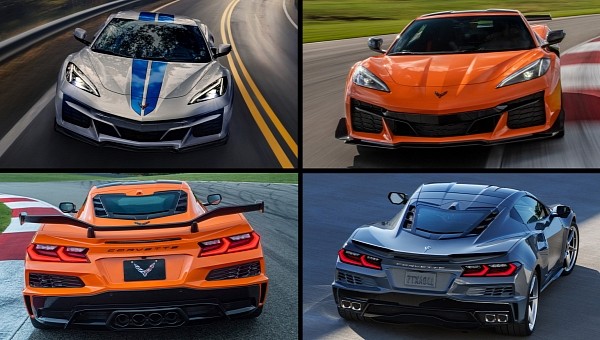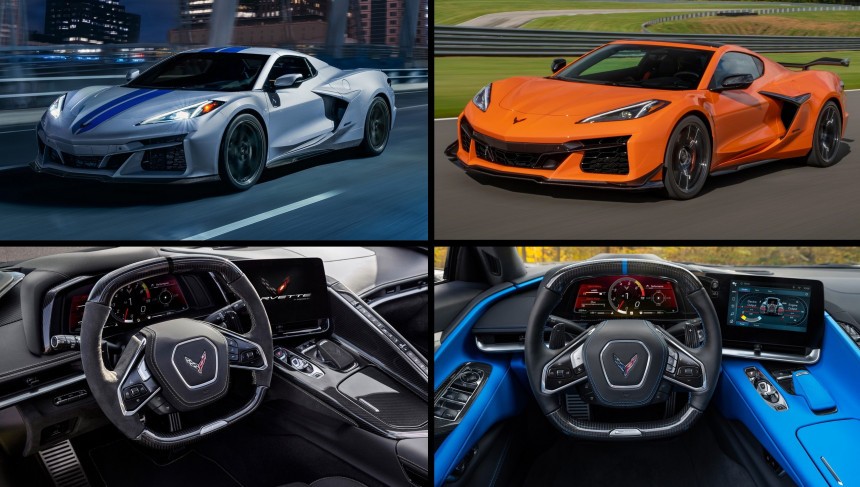The eighth-generation Chevrolet Corvette is all about breaking boundaries and setting new limits to what the perfect American sports/supercar should be. Not only it is the first-ever mid-engine ‘Vette, yet it has now tapped into its electrified side too with the brand-new E-Ray, which is also the first AWD Corvette in history. But is the hybrid a better proposal than the Z06?
First of all, let’s see what separates the two, and since the obvious answer is the powertrain, we’ll kick it off with the technical specs. In case you missed it, the new Chevrolet Corvette E-Ray uses the same engine as the Stingray, namely the LT2 6.2-liter V8. It pumps out an identical 495 hp (502 ps/369 kW) and 470 lb-ft (637 Nm) of torque.
While the internal combustion unit sets the rear wheels in motion via a dual-clutch eight-speed automatic transmission, a new electric motor drives the front ones. It generates 160 hp (162 ps/120 kW) and 125 lb-ft (170 Nm) of torque and contributes to the total output that is rated at 655 hp (664 ps/489 kW). The E-Ray is the quickest ‘Vette in history, taking 2.5 seconds to hit 60 mph (97 kph) from a standstill, obviously in the dry, which is basically hypercar territory, before completing the quarter mile in 10.5 seconds.
Mounted between the seats, beneath the center tunnel, the tiny battery has a 1.9 kWh capacity and feeds juice to the electric motor. This should be enough to allow it to drive on electricity alone for a limited period, which could be around two miles or so. Thus, if you were hoping to get to and from the office on zero emissions, then the Corvette E-Ray shouldn’t be the first choice. Maybe they should have fitted it with a plug-in hybrid powertrain instead, giving it a bigger battery, but that would have had a big impact on the pricing and performance of the electrified model.
Packing a double-overhead-cam 5.5-liter flat-plane crank LT6 V8, the Corvette Z06 from the C8 generation boasts 670 hp (680 ps/500 kW) and 460 lb-ft (623 Nm) of torque. It can be revved all the way up to 8,600 rpm and works in concert with an eight-speed dual-clutch automatic transmission and rear-wheel drive. The LT6 took a lot of time to develop, as the bowtie brand didn’t have any experience with making such engines, and they actually went on eBay and bought a V8 that came from a Ferrari 458 to learn its secrets. Even if it is slightly lighter than the E-Ray, the Z06 has less thrust and is therefore a bit less agile. The 0-60 mph sprint is a 2.6-second affair, and the quarter mile is dealt with in 10.6 seconds.
Leaving the technical specs and straight-line performance of the two aside, let’s move on to the visuals, and telling them apart isn’t that hard, even if you are not a ‘Vette fanatic. The front bumpers are different, with that of the E-Ray having a more intricate design, and the same goes for the rear ends too, where the electrified model looks a bit simpler than its sibling. Both have quad exhaust tips, but the Z06 wears them in the middle, with a big cutout in the diffuser, whereas the E-Ray has two of them behind each rear wheel. Also, the Z06 boasts a big wing for enhanced aero, and it has a chunkier apron attached to the front bumper too.
Thanks to the twisted five-spoke design, the wheels of the hybrid model are exclusive to it, and the same goes for the Electric Blue racing stripes, which are options. And speaking of things that cost more, these also include that Artemis Dipped green interior trim, which will otherwise be limited to 2024 Corvettes, and two carbon trim packages. The longer and wider bodies, as well as the smaller rear air vents, are some of the things that the two have in common, next to other stuff, including a choice between the coupe and convertible body styles, which tip the scales at 3,774 and 3,856 lb (1,712-1,749 kg), respectively. The fixed-roof version of the Z06 weighs 3,434 lb (1,561 kg), and the base C8 is 3,366 lb (1,530 kg).
In terms of pricing, you are looking at a minimum of $104,295 for the Corvette E-Ray. This makes it roughly $1,000 more affordable than the Corvette Z06, which starts at $105,300. For the base Corvette Stingray, on the other hand, you will have to fork out at least $64,500, before destination, dealer fees, and options. So, if you had to choose between the E-Ray and the Z06, which one would you go for and why? Also, would you rather have had the electrified ‘Vette with a plug-in hybrid powertrain instead of the self-charging setup, and the obvious price bump? Let us know what you think about it by dropping a line down below.
While the internal combustion unit sets the rear wheels in motion via a dual-clutch eight-speed automatic transmission, a new electric motor drives the front ones. It generates 160 hp (162 ps/120 kW) and 125 lb-ft (170 Nm) of torque and contributes to the total output that is rated at 655 hp (664 ps/489 kW). The E-Ray is the quickest ‘Vette in history, taking 2.5 seconds to hit 60 mph (97 kph) from a standstill, obviously in the dry, which is basically hypercar territory, before completing the quarter mile in 10.5 seconds.
Mounted between the seats, beneath the center tunnel, the tiny battery has a 1.9 kWh capacity and feeds juice to the electric motor. This should be enough to allow it to drive on electricity alone for a limited period, which could be around two miles or so. Thus, if you were hoping to get to and from the office on zero emissions, then the Corvette E-Ray shouldn’t be the first choice. Maybe they should have fitted it with a plug-in hybrid powertrain instead, giving it a bigger battery, but that would have had a big impact on the pricing and performance of the electrified model.
Leaving the technical specs and straight-line performance of the two aside, let’s move on to the visuals, and telling them apart isn’t that hard, even if you are not a ‘Vette fanatic. The front bumpers are different, with that of the E-Ray having a more intricate design, and the same goes for the rear ends too, where the electrified model looks a bit simpler than its sibling. Both have quad exhaust tips, but the Z06 wears them in the middle, with a big cutout in the diffuser, whereas the E-Ray has two of them behind each rear wheel. Also, the Z06 boasts a big wing for enhanced aero, and it has a chunkier apron attached to the front bumper too.
Thanks to the twisted five-spoke design, the wheels of the hybrid model are exclusive to it, and the same goes for the Electric Blue racing stripes, which are options. And speaking of things that cost more, these also include that Artemis Dipped green interior trim, which will otherwise be limited to 2024 Corvettes, and two carbon trim packages. The longer and wider bodies, as well as the smaller rear air vents, are some of the things that the two have in common, next to other stuff, including a choice between the coupe and convertible body styles, which tip the scales at 3,774 and 3,856 lb (1,712-1,749 kg), respectively. The fixed-roof version of the Z06 weighs 3,434 lb (1,561 kg), and the base C8 is 3,366 lb (1,530 kg).
In terms of pricing, you are looking at a minimum of $104,295 for the Corvette E-Ray. This makes it roughly $1,000 more affordable than the Corvette Z06, which starts at $105,300. For the base Corvette Stingray, on the other hand, you will have to fork out at least $64,500, before destination, dealer fees, and options. So, if you had to choose between the E-Ray and the Z06, which one would you go for and why? Also, would you rather have had the electrified ‘Vette with a plug-in hybrid powertrain instead of the self-charging setup, and the obvious price bump? Let us know what you think about it by dropping a line down below.














